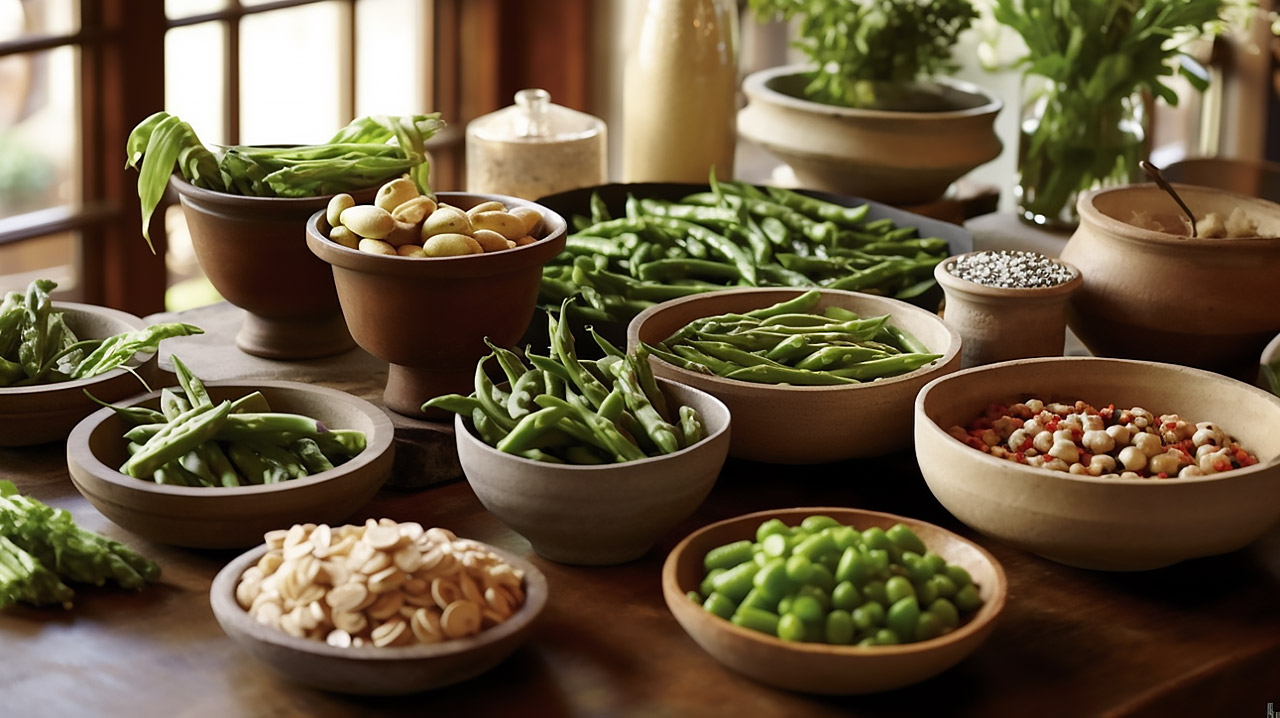Follow us 261.1k
Quick Summary tl;dr
While legumes are a nutritious part of many diets, they can be high in carbohydrates. For those following a low-carb or ketogenic diet, there are plenty of alternatives available. Whether you're looking for a substitute for peas, lentils, beans, chickpeas, or soybeans, there's a low-carb alternative out there that can help you enjoy your favorite dishes while keeping your carb intake in check.
Not all legumes are high in carbohydrates. Some legumes, including green peas, sugar snap peas, green beans, lupin beans, peanuts, and certain types of soybeans, are relatively low in carbs. However, peanut butter can be high in carbs due to added sugars, and soybeans are known endocrine disruptors.
The goal isn't necessarily to find a direct one-to-one replacement for a specific legume. Instead, the focus is on finding ingredients that can fulfill a similar role in a recipe or meal.
Some of the alternatives include zucchini, cauliflower, or macadamia nuts. For instance, these ingredients can be used to make low-carb hummus, providing a delicious, creamy spread that closely mimics the texture and flavor of traditional hummus.
Other low-carb alternatives to legumes include chopped nuts, hemp hearts, edamame, eggplant, green beans, and sugar snap peas. However, some options, like black soybeans and seitan, are less ideal due to their overall nutritional profile and potential health effects.
Legumes, including beans, lentils, peas, and chickpeas, are a staple in many diets worldwide. They are packed with protein, fiber, and various vitamins and minerals. However, they are also high in carbohydrates, which can be a concern for those following a low-carb or ketogenic diet.
This guide will provide you with a range of low-carb alternatives to legumes, allowing you to enjoy your favorite dishes while keeping your carb intake in check.
What Are Legumes?
Legumes are a family of plants that produce a pod with seeds inside. The term "legume" is used to describe these seeds, which include beans, lentils, peas, and chickpeas. Legumes are known for their high protein content, making them a popular choice among vegetarians and vegans. However, most of them contain significant amounts of carbohydrates.
Are All Legumes High-Carb?
No, not all legumes are high in carbohydrates. So before we delve into the alternatives, it's worth noting that some legumes are relatively low in carbs. These include green peas, sugar snap peas, green beans, lupin beans, peanuts, and certain types of soybeans.
However, keep in mind that while peanuts are low in carbs, peanut butter can be high in carbs due to added sugars and may not be suitable for everyone. In such cases, always opt for plain, unsweetened peanut butter. Alternatively, you can opt for nut and seed butter, or coconut butter, also known as coconut manna.
Soybeans, while low in carbs, are known endocrine disruptors and are still not that low in carbs. When it comes to soy, two types are acceptable: edamame (young soy beans) and fermented soy products.
Why Use Low-Carb Alternatives to Legumes?
While legumes have many health benefits, most types can be problematic for those following a low-carb or ketogenic diet. These diets aim to reduce carbohydrate intake, forcing the body to use fat as its primary energy source, keeping blood sugar levels stable, and naturally suppressing appetite.
By finding low-carb alternatives to legumes, you can still enjoy the flavors and textures you love without exceeding your daily carb limit.
Do Low-Carb Alternatives to Legumes Work Well in Recipes?
When it comes to finding low-carb alternatives to legumes, it's important to understand that the goal isn't necessarily to find a direct one-to-one replacement for a specific legume. Instead, the focus is on finding ingredients that can fulfill a similar role in a recipe or meal.
For instance, while zucchini, cauliflower, or macadamia nuts might not seem like natural stand-ins for legumes, when they're incorporated into recipes, they can truly shine. A perfect example of this is in the creation of low-carb hummus. Traditional hummus is made with chickpeas, a high-carb legume. However, when you substitute chickpeas with cauliflower or zucchini and blend with tahini, garlic, and lemon juice, the result is a delicious, creamy spread that closely mimics the texture and flavor of traditional hummus.
Many people find that in the context of a dish like this, they can't even tell that legumes have been swapped out for a low-carb alternative. It's all about getting creative with your ingredients and understanding how their flavors and textures can work together in a dish.

Low-Carb Alternatives to Peas (Split or Whole)
Zucchini
Zucchini can be chopped into small pieces and used in recipes in place of peas. Although the texture is different when cooked, they can absorb the flavors of the dish, just like peas.
Try these recipes with zucchini:
Sugar Snap Peas
Sugar snap peas are relatively low in carbs and high in vitamin C. They are perfect for stir-fries and quick meals.
Try these recipes with sugar snap peas:
Low-Carb Alternatives to Lentils
Chopped Nuts
For a crunchy texture similar to cooked lentils, chopped nuts such as almonds or walnuts can be used. They also add healthy fats to the dish. However, they are high in fat and calories so they should only be used sparingly in salads rather than as a full side serving.
Hemp Hearts
These can mimic the texture of cooked lentils and are a great source of plant-based protein and magnesium, an electrolyte that is particularly important when you go low-carb. Similarly to nuts, they are high in fat and should be used in moderation.
Low-Carb Alternatives to Beans
These are some of the best low-carb alternatives to beans including black, pinto, kidney, etc.
Edamame
Young soybeans, or edamame, are lower in carbs than most beans and can be used in a variety of dishes. Just like fermented soy products, edamame can be enjoyed in moderation. Also, edamame are not as low in carbs as most of the other alternatives so keep that in mind when using in recipes.
Eggplant
Eggplants, also known as aubergines, are a great option for stews and curries. Although their texture is different to beans, they can absorb the flavors of the dish, and make it just as satisfying.
Try these recipes with eggplant:
Green Beans
Green beans are a fantastic low-carb option. Chop them into bite-sized pieces, or leave them whole and add to in soups, stews and curries instead of beans.
Try these recipes with green beans:
Lupini Beans (Lupin Beans)
Lupini beans and lupini bean products are relatively low in carbs. They are probably the closest you will get to enjoying authentic flavor and texture.
Before you use lupin beans: There is conflicting information about their actual carb count (raw lupin beans vs lupin flakes) so it may be worth doing a blood glucose test to see how they affect you. Just like peanuts, lupin flakes are made from beans and are legumes. Although they are low in carbs, not everyone can tolerate legumes or may even be allergic to them. Peanut and nut allergy sufferers beware! Also make sure that you only purchase lupin flakes from a reputable source. Improper preparation of lupin beans results in toxicity from excess alkaloids that have not properly been removed by soaking. Such lupin products would taste bitter.
Low-Carb Alternatives to Chickpeas
Raw or Roasted Nuts or Seeds
Did you know that macadamia nuts are a fantastic option to use when making hummus? It's so good, you won't even know there are no chickpeas. Apart from being a fantastic source of monounsaturated fats, macadamia nuts are also the lowest carb nut that's lowest in anti-nutrients, and lowest in omega-6 fats.
Try this Easy Macadamia Hummus for the most authentic experience. And if you want to add some potassium and more heart-healthy fats, give this Avocado Hummus a try! You can serve any of the low-carb hummus recipes with fresh vegetables such as bell peppers, celery sticks or these Multiseed Crackers.
Other nuts can be used too. For a crunchy, high-protein snack similar to roasted chickpeas, try roasting nuts or seeds like pumpkin seeds or almonds.
Cauliflower
When roasted, cauliflower can take on a texture similar to chickpeas and can be used in recipes like mock hummus like this Buffalo Cauliflower Hummus.
Zucchini
Zucchini is a fantastic option for making low-carb, legume-free hummus that's high in electrolytes, low in carbs and calories. This Roasted Zucchini Hummus is a great example of how you can use this low-carb vegetable to make a healthier version of hummus.
The Less Ideal Options
The following options are low in carbs, however, they are included in the "less ideal" list due to their overall nutritional profile and potential health effects. Furthermore, these are not the options we would recommend if you follow a healthy, whole foods based low-carb diet.
Black Soybeans
While most soy products are high in carbs, black soybeans are an exception. They can be used as a direct substitute for black or pinto beans in most recipes. However, it's important to note that soy products are associated with several health concerns, particularly due to their potential hormone-disrupting effects.
Seitan
Seitan, while not suitable for those with gluten intolerance, is a high-protein, low-carb alternative to soybeans. However, it's worth noting that consuming seitan means ingesting a significant amount of gluten, which may have long-term implications for some individuals, especially those with autoimmune health conditions.
How to Use These Alternatives in Cooking
Each of these alternatives can be used in a variety of ways in your cooking as explained in the section above. For example, zucchini can be used in place of peas in a stir-fry, while chopped nuts can add a crunchy texture to salads in place of lentils.
Edamame beans can be used in place of beans in dishes like chili or burritos, while roasted nuts or seeds and cauliflower can be used as a snack or in dips in place of chickpeas.
Macadamia nuts, zucchini, eggplant and cauliflower can be used to make hummus. Ideally, use raw macadamia nuts as they will taste more neutral compared to roasted nuts. If you use vegetables such as zucchini, eggplant, or cauliflower, it's best to roast them in the oven or an air fryer before blending them for extra flavor.
Finally, roasted or steamed green beans are the ideal side to serve with any proteins, in salads, or on their own with some dips and dressings.
Conclusion
While legumes are a nutritious part of many diets, they can be high in carbohydrates. For those following a low-carb or ketogenic diet, there are plenty of alternatives available. Whether you're looking for a substitute for peas, lentils, beans, chickpeas, or soybeans, there's a low-carb alternative out there that can help you enjoy your favorite dishes while keeping your carb intake in check.
Do you like this post? Share it with your friends!
Let us know what you think, rate this post!
